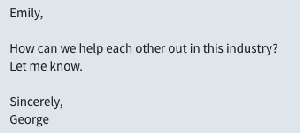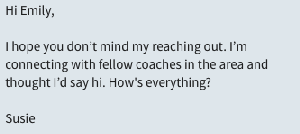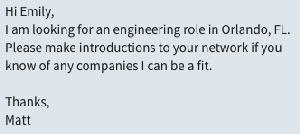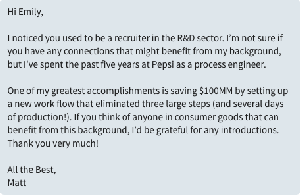Author: Emily Liou
As a career coach, my inbox is often flooded with messages from people I’m connected with on LinkedIn who are reaching out about something or another. Now, I don’t mean to be judgmental, but I often find myself sighing with annoyance when I open them up—so much so that I was motivated to write this article.
You see, the thing is, I’m open to making new connections and willing to talk to anyone, so the fact that I often put off responding to messages means people are missing the mark. And that stinks because it takes effort to both find people to connect with in the first place and then cultivate a networking relationship from there.
I want to be excited when I read your message and I know you want that, too (or at least I hope you do!). Often times, it only takes a few tweaks to your words or tone to make that possible.
Below are messages inspired by real ones I’ve received along with my thoughts on why they’re not the best approach.
Quick note though: Unless you have LinkedIn Premium, you’ll need to connect before you send a message. But that doesn’t mean you can just send the generic invite. Instead, send a customized one with with these short templates so they’ll accept your request and you’ll be able to actually send over a note.
1. The Empty Query

Initial Reaction
It’s nice that you want to find a way to help one another out, but this message doesn’t give me anything to work with. Perhaps there’s something in my my background that led you to reach out in this manner?
Revised

Why This Is Better
Anyone can spot a generic, non-customized message from three Wi-Fi zones away, and if you care about standing out, you’ll be careful not to be labeled as generic, right? The updated version attempts to start building a rapport. By including a customized, targeted line, I can tell George has looked into my background and is excited about finding a way to potentially work together. And that makes me much more inclined to respond to this.
2. The Vague Ask

Initial Reaction
How’s everything? Hm, that’s a rather large question for someone I don’t know in real life. In fact, I’m not sure I’d even know where to begin in responding to this person.
The Revised Message

Why This Is Better
Being clear up front is just good business. It sets clear intentions and demonstrates professionalism. Many people have experienced accepting a meeting only to find it turn into a sales pitch. If you’re clear about the reason why you’re reaching out, you’re going to build a higher level of trust out the gate and find people who are attracted to your proposal. This is what building a network is all about.
3. The Forceful Demand

Initial Reaction
Hi Matt. My current profile has been updated to indicate that I’m no longer a recruiter (not to mention I definitely don’t specialize in the Florida market as I’m in Los Angeles). If you’re going to spend the time, energy, and effort in sending messages and attempting to foster relationships, it’s far more more effective if you target the correct audience.
The Revised Message

Why This Is Better
If you’re actively seeking a new position and are wanting to connect, it makes a huge difference if you can share in a couple of sentences what you’re looking for and a glimpse of what you bring to the table. Even though I’m no longer entrenched in the recruiting world, I’m still well-connected.
If Matt had demonstrated clear professionalism in a straightforward introduction, and made note of target roles he’s seeking, I’d for sure be inclined to point him to resources or ask him for his resume to pass along.
The thing to remember is that if you’re asking one of your LinkedIn contacts for something, you need to make it as easy as possible for that person to follow up.
It may be difficult to see it, but every piece of correspondence counts—from the way you first connect to how you stay connected. Don’t randomly reach out to 20 of your LI connections for the sake of hoping something falls into place in your job search. By building off of the revised templates above, you’ll be able to initiate conversations that result in meaningful networking relationships.
Photo credit: wernerimages/Getty Images.
To read the original article, click here.

